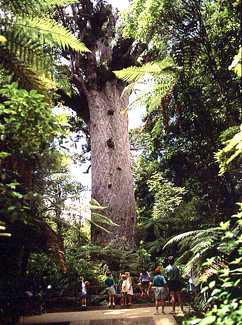




| This is a picture of a Kauri tree; Agathis australis (still alive today in New Zealand) that produces Kauri gum. Kauri gum is recently formed resin, (usually less then 50 000 years old, (Poincar 1994)) that is sometimes classified as a gum or as a Copal. |

George Poincar defines Copal as "a
recently deposited resin that cannot be molded by hand, has a
melting point under 150ºC, a surface that partially dissolves
(becomes sticky) when acetone is applied
and is relatively soft (can be scratched with a fingernail). (Poincar
1992)
Poincar also calls copal "a subfossil
stage" [of amber]. (Poincar 1992)
Copal can be considered to be young or immature
amber, but it is more mature then resin, (the gooey stuff!).
The maturity of a resin depends
on the degree of polymerization of certain types of molecules
within the resin structure. Maturity is not however to be
confused with the actual age of the resin in question.

